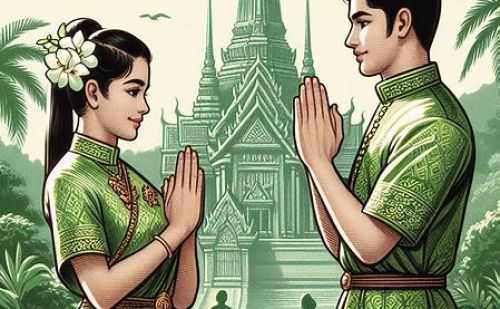The Wai gesture of greeting
The Wai gesture of greeting
The Wai gesture of greeting is a common way of showing respect and politeness in Thailand. It consists of a slight bow, with the palms pressed together in a prayer-like fashion. It has its origin in the Indian Añjali Mudrā, like the Indian namaste and Burmese mingalaba. The position of the hands and the depth of the bow indicate the level of respect for the person being greeted. The Wai can also be used to say goodbye, thank you, apologize, or express reverence
Some additional sentences are:
The Wai is an important part of Thai culture and etiquette, and it is expected to be returned by the person who receives it, unless they are of higher status or age
The Wai is also performed to temples, monuments, pictures, and spirit houses, as a way of honoring the sacred or the divine
The Wai is similar to the gestures used in other countries that have been influenced by Hinduism and Buddhism, such as Cambodia, Laos, Myanmar, and Sri Lanka
What is the wai gesture?
The wai gesture is a common way of showing respect and politeness in Thailand. It consists of a slight bow, with the palms pressed together in a prayer-like fashion. It has its origin in the Indian Añjali Mudrā, like the Indian namaste and Burmese mingalaba. The position of the hands and the depth of the bow indicate the level of respect for the person being greeted. The wai can also be used to say goodbye, thank you, apologize, or express reverence
Some additional sentences are:
The wai is an important part of Thai culture and etiquette, and it is expected to be returned by the person who receives it, unless they are of higher status or age
The wai is also performed to temples, monuments, pictures, and spirit houses, as a way of honoring the sacred or the divine
The wai is similar to the gestures used in other countries that have been influenced by Hinduism and Buddhism, such as Cambodia, Laos, Myanmar, and Sri Lanka
What is the traditional Thai greeting?
The traditional Thai greeting is called the wai. It is a gesture that consists of a slight bow, with the palms pressed together in a prayer-like fashion. It is used to show respect, gratitude, apology, or reverence. The position of the hands and the depth of the bow indicate the level of respect for the person being greeted. The wai is usually accompanied by the word sawasdee, which means hello, goodbye, or good day. Women say sawasdee kha and men say sawasdee khap. The wai is an important part of Thai culture and etiquette, and it is expected to be returned by the person who receives it, unless they are of higher status or age
How do you properly use Wai?
To use the wai gesture properly in Thailand, you need to consider the social status and age of the person you are greeting. The wai is a way of showing respect and politeness, and it is expected to be returned by the person who receives it, unless they are of higher status or age. The basic steps of performing a wai are as follows :
Press your palms together in front of your chest, with your fingers pointing upwards and your elbows tucked in.
Lower your head slightly so that your index fingers touch your nose or your chin, depending on the level of respect you want to show.
Say “sawasdee kha” if you are a woman, or “sawasdee khap” if you are a man, to say hello, goodbye, or good day.
The position of your hands and the depth of your bow indicate the level of respect for the person being greeted. There are three main types of wai, depending on the status of the person you are greeting:
For friends, peers, or people of the same age or status as you, you can use the basic wai described above.
For people who are older, more senior, or more respected than you, such as your boss, teacher, or parents, you can raise your thumbs to the tip of your nose and your index fingers to your forehead, and lower your head more.
For people who are very highly respected, such as monks, the royal family, or statues of Buddha, you can lower your head until your thumbs are in-between your eyebrows and your palms are at your chest, and bow slightly.
You should not wai people who are younger, lower, or less respected than you, such as children, service staff, or beggars, as this may make them feel uncomfortable or embarrassed. You can simply smile or nod to them instead
What does Namaste mean in Thai?
Namaste is a traditional Indian greeting which can be translated to mean “I bow to you” or “I greet the divine in you.” Saying namaste is a way of showing respect and can be used as a hello or goodbye. In Thai, the word for namaste is sawasdee (สวัสดี). Sawasdee is also a common and useful Thai greeting that can be used anytime of the day. It is usually accompanied by the polite word kha for women and khap for men, and the wai gesture, which consists of a slight bow with the palms pressed together in front of the chest. For example, a woman saying hello in Thai would say “Sawasdee kha” and a man would say “Sawasdee khap”.
What are some other Thai customs?
Some other Thai customs that you might encounter or want to know are:
Thai smile: Thai people are known for their friendly and cheerful smiles, which can convey different meanings depending on the context. A smile can be a way of greeting, expressing gratitude, apologizing, showing embarrassment, or hiding emotions. It is considered polite and respectful to smile back when someone smiles at you.
Thai food: Thai cuisine is one of the most popular and diverse in the world, with influences from China, India, Malaysia, and other neighboring countries. Thai food is characterized by its use of fresh herbs, spices, coconut milk, fish sauce, and chili peppers, creating a balance of sweet, sour, salty, bitter, and spicy flavors. Some of the most famous dishes are tom yum goong (spicy shrimp soup), pad thai (stir-fried noodles), green curry, and mango sticky rice.
Thai festivals: Thailand has many colorful and lively festivals throughout the year, celebrating various aspects of its culture, religion, and history. Some of the most well-known festivals are Songkran (Thai New Year), Loy Krathong (festival of lights), Yee Peng (lantern festival), and Vegetarian Festival . These festivals often involve water splashing, candle lighting, lantern releasing, or abstaining from meat, as ways of showing respect, gratitude, or purification.
Thai etiquette: Thai people are generally polite and respectful, and they expect the same from visitors. There are some rules of etiquette that you should follow when in Thailand, such as :
Do not touch or point at anyone’s head, as it is considered the most sacred part of the body.
Do not show the soles of your feet, as they are considered the most unclean part of the body.
Do not point or gesture with your index finger, as it is considered rude and aggressive.
Do not criticize or insult the royal family, the religion, or the country, as it is considered a serious offense.
Do not display public affection, such as kissing or hugging, as it is considered inappropriate and disrespectful.
Do dress modestly and appropriately, especially when visiting temples or religious sites.








